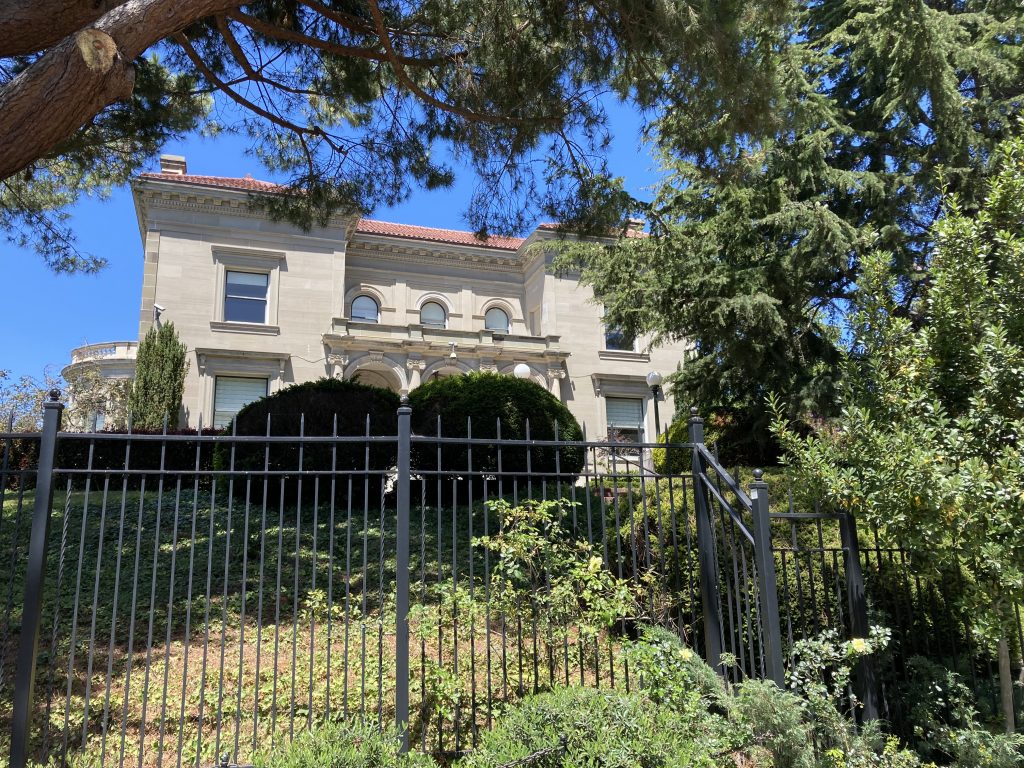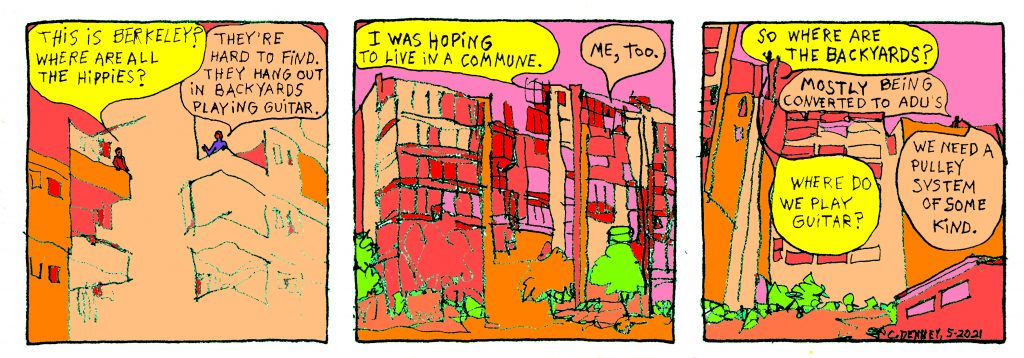
The most recent University of California (UC) plan for People’s Park is nothing new. One previous plan envisioned paving over the community garden for a large, outdoor commercial cafe. The architectural rendering included lots of relaxed little white people seated around charming tables. One plan unilaterally installed a UC parking lot which community members removed with their bare hands and with pickaxes under the protective eye of then-Mayor Gus Newport, asphalt still visible in the landscaped berms at either end of a decades-old community garden. Today’s plan, a seventeen-story monolith of for-profit housing for students (with poor people segregated in an entirely separate building) is a complete destruction of the entire park on the basis of a need for housing.But is it housing? Even students who can afford high-end, for-profit rates can only live there two years before being kicked out into a town UC has helped denude of the flexible, affordable, permanent housing it tore down in 1967 on the same block. The UC’s current Long Range Development Plan (LRDP) envisions doing the same thing to the rent controlled units of a landmarked building at 1921 Walnut Street, replacing them with luxury units unaffordable to most students and unavailable to those who aren’t students or who’ve maxed out their two-year stay.
Real estate’s current affection for luxury student units is not a local phenomenon; it is the latest get-rich-quick scheme for developers from coast to coast. It distorts communities from Berkeley to Boston with lucrative investment opportunities for those for whom the pandemic requires nothing but re-parking investment money while most of us scramble to rebuild our lives. The impermanence, cost, and availability to students only mean most of us wouldn’t or couldn’t consider living there. They replace the previous flexible, affordable housing which is the only practical way to address today’s housing crisis and maintain the diversity most of us would agree is culturally and morally crucial.
Politicians and developers form a symbiotic partnership when building new housing, a relationship often cast as the savior in a housing emergency. Developers present high-end, for-profit housing units as “solutions,” and contribute mightily at election time. But profit-driven new development contracts are often only temporary shelters, housing so specialized it’s only available to teachers, or seniors, or specifically registered students for exactly two years and beyond the budget of ordinary renters. It transforms rent-controlled housing into non-rent-controlled, high-end rentals or leased units. The contracts are written in such a way that the housing costs are easily re-set to outrageous, unaffordable market rates with every new tenancy. None of the new housing in Berkeley functions as seamlessly as the original housing that the University of California bulldozed in 1967 on the block that is now People’s Park.
The units they want to build now, 54 years later, are a simple disguise for a way to take a public park and monetize it for the sole benefit of the University of California without disrupting the expansive green lawns on its main campus, such as the completely empty Chancellor’s House, a two and one-half acre site almost identical in size to People’s Park. Similarly, the 9.26 acres of UC’s former seven two-story Smyth-Fernwald residence halls only two blocks from campus, which were damaged in the 1989 earthquake and torn down, sit empty. This ten-acre, UC-owned property which formerly provided hundreds of student and faculty post-war units, is three times the size of People’s Park.
But there’s no need to cannibalize Berkeley; recent court cases clarify that UC’s over-enrollment and deceit regarding its enrollment numbers are violations of both the California Environmental Quality Act (CEQA) and its agreements with the City of Berkeley.
There are numerous alternate locations where the UC could build housing without demolishing affordable housing or building on historic sites, parks, and gardens. But no one should limit their view of UC’s potential housing sites to the nine sites self-selected by UC, which, as California’s largest property owner and employer, has almost unlimited properties to choose from. No matter how desperately they paint their financial straits, their budget always includes $10 million-dollar salaries for the football coach and funding to acquire more and more of the City of Berkeley’s finite square footage. If anything, the nine sites UC selected are a perfect recipe for pitting neighborhood against neighborhood, rather than utilizing a wide variety of less impactful sites to situate a smaller, more appropriate enrollment.

If we made it a crime for housing to sit empty for more than two days, the housing crisis would be over. And if UC Berkeley were required to situate its students and faculty on its own campus, rather than ravage the parks and planning of its host town—which the current mayor is more than eager to do—it would only reduce two or three of its yawning lawns, lower its student and faculty commutes, and give Berkeley the breathing room it needs to recover from the pressure recognized recently by an Alameda County Superior Court judge:
“Judge Seligman ruled that UC Berkeley abused its discretion when it failed to study the impacts of increasing its student enrollment by 33.7 percent — and told the university it must do a more comprehensive review” (Berkeleyside, July 13, 2021).
We know what housing looks like. Temporary shelters are not housing: nobody can call it housing when it comes with an absurd time limit. You can only be evicted from real housing for cause. Two years of high-end, for-profit housing, gouging the pockets of out-of-state students, is no substitute for real housing and honest efforts to permanently address the housing crisis.
The monetization of public lands is not wise policy, it simply caters to the private interests unbalancing the UC system and the politicians unable or unwilling to take a stand for Berkeley voters. Indeed, in 1988, Berkeley voters overwhelmingly said no to developer exploitation by passing Measure N, a measure affirming their desire to have their local laws, planning documents, and ordinances respected. This came only two years after the passage of Measure L, which requires the Berkeley City Council not just to protect parks and open space but to work to acquire more.
Before the iconic campanile disappears forever behind unaffordable high-rises, join the neighborhood and community groups demanding that the voter-affirmed policy direction of Measures N and L be respected. Democracy, free speech, and our community’s safety from years of predictable, expensive conflict are at stake. All of our parks, especially one recognized by the state as an historic resource, are worth respecting and preserving for future generations and our own.
Carol Denney is a writer, poet, and musician who lives in the East Bay.
